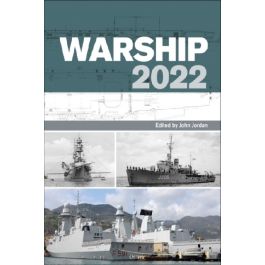Warship 2022
Product Review (submitted on 23 May 2022):
The Warship annual series can always be relied upon to highlight the innovative designs of their day along with the less successful concepts, and the 2022 edition is no exception. With articles covering the Soviet destroyer programme of the 1920s, RN radar development and current European frigate design evolution, there is a wealth of material from an impressive array of contributors - Warship annuals literally have something for everyone.
The Soviet destroyer programme was conducted against the ever present menace of political interference at a time of Stalin’s rise to power. Speed was “a fetish of the military” and failure to achieve design speeds often led to imprisonment. Continual delays caused by industrial issues led to the steam valve box of the Minsk being cast 46 times before a satisfactory result. The development and build of the Australian Bathurst Class showed what could be done as the need for escort sloops capable of ASW and minesweeping – an interesting mix – resulted in locally built ships to commercial standards. Described as uncomfortable ships to serve in –“petulant, cantankerous, moody and capricious” - they were the largest class of warships built in Australia and the Castlemaine survives as a museum ship.
The “Tunnel” operations conducted at night by the Royal Navy against German coastal shipping off the Brittany coast in 1943-44 were strategically important but hazardous, not least because the Germans had good coastal radar. The German Elbing class were more than match for the RN Hunts, backed up by a Dido class cruiser. The loss of the Charybdis and a Hunt in October 1943 caused by insufficient planning and experience resulted in the loss of over 500 men. With the arrival of more powerful Tribal class, more stable leadership and better training, the operations were more successful.
A series on post war RN radar development includes the 27 ton “searchlight” Type 984 radar of 1959 as fitted to Victorious and Hermes. Despite having nearly 9000 valves and over 47,000 resistors it was more advanced than USN designs of the time. Sadly, development in in the 1970s made “little or no progress” and the Falklands Task Force with “antique” radars suffered accordingly. An in depth assessment of current European frigate designs shows the increasing emphasis on modularity allowing for containerised weapons fits, and produces flexible designs such as the Danish Ivor Huitfeldt and Type 31. The Franco/Italian FREMM designs have led to the USN choosing the Italian version as a basis for its new FFG-62 Constellation Class. Other ships include the impressive looking German F125 and the RN Type 26 “the standard for surface combatant design trends” with its RAN and RCN spin offs. For the future, unmanned platforms will become the driver for change.
Other articles cover another of those magnificent looking French battleships of the early 20th Century, the Jaureguiberry, the successful Japanese medium sized carriers Hiryu and Soryu, German colonial era gunboats, Italian scout cruisers, 1930’s Soviet battleship plans, the genesis of the Japanese Yokosuka shipyards and a photo gallery of the scrapping of the Agincourt, New Zealand and Princess Royal at Rosyth 1923-25.
A superb collection of fascinating essays, beautifully presented and published, this series never fails to deliver- and Jordan has already planned next year’s edition! Very highly recommended.

